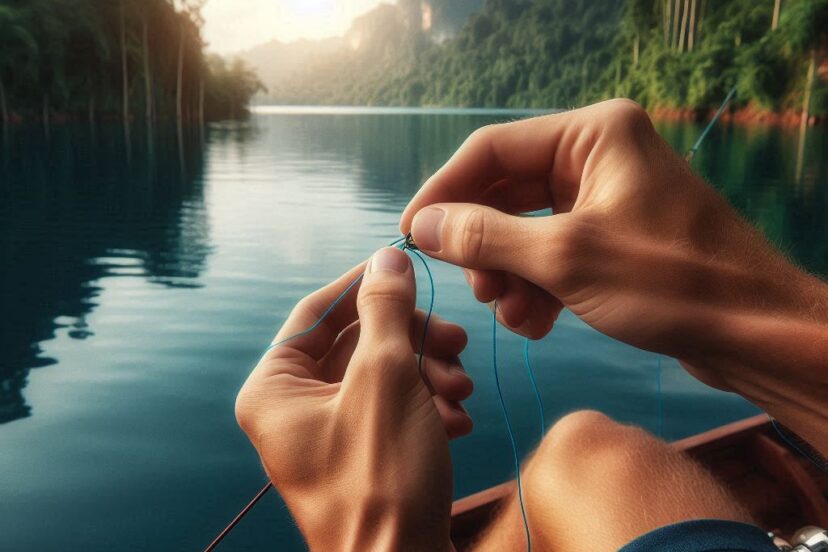Best Fishing Knots for Stronger Connections
*We may earn a commission for purchases made using our links. Please see our disclosure to learn more.
Best Fishing Knots: Essential Techniques for Every Angler
When it comes to fishing, a strong knot is the secret to a great catch. I’ve spent years perfecting different knots, and I know which ones hold up the best under pressure. The best fishing knots are not just about strength but also about ease of tying, reliability, and suitability for different types of fishing lines and connections.
The Palomar knot is my go-to for its simplicity and strength, making it ideal for many situations. A unique favorite of mine is the FG knot, especially useful for heavy lines and offers incredible strength with a small profile. Whether you’re a seasoned angler or new to fishing, mastering these knots can make a significant difference in your fishing success.
Tying the right knot can mean the difference between a story-worthy catch and a lost opportunity. From the trusted Double Uni knot for joining lines to the versatile Arbor knot for connecting lines to a reel, knowing these essential knots will prepare you for any fishing scenario. Let’s dive into the world of fishing knots, and you’ll discover which ones are most suited for your next fishing adventure.
Essentials of Fishing Knots
When it comes to fishing, the right knot can make all the difference. It affects how well the line holds and can impact your success on the water. I’ll dive into the strength of knots and the factors that influence how they perform.
Understanding Knot Strength
Knot strength is crucial because a strong knot ensures that your line stays secure under pressure. The strength of a knot depends on how well the turns and loops lock together. It’s essential to choose a knot that retains most of the line’s original strength. For example, the Palomar knot is popular because it maintains a high percentage of the line’s strength. Testing different knots with your specific line helps in finding the best match. Remember, a well-tied knot gives you the confidence that your setup can handle any fish that bites.
Factors Affecting Knot Performance
Several factors can affect how a knot performs. The type of line—whether it’s monofilament, fluorocarbon, or braided—greatly influences knot holding power. Moistening the line before tightening it can reduce friction and prevent damage. The number of twists and turns also plays a role; too few may weaken the knot, while too many can cause tangling. Practicing each knot helps improve speed and efficiency, but more importantly, ensures the knot is tied correctly, maximizing performance. Taking these elements into account ensures a well-tied knot that you can rely on during any angling adventure.
Types of Fishing Knots
In fishing, knots are crucial for securing hooks, lures, and connecting lines. Each type of knot has unique benefits and is suited for specific tasks. Knowing the right knot can make a big difference in a successful fishing trip.
Loop Knots
Loop knots are essential when you need a non-slip loop at the end of your line. These knots allow lures and bait to move freely, making them more attractive to fish. A popular choice is the Perfection Loop, known for its strength and ease of tying.
When I tie a loop knot, it often involves a small initial loop, wrapping the main line around it, and threading the end back through. Uni Knot and Palomar Knot are also versatile choices, though the Palomar is typically used for direct attachments rather than loops. Mastering loop knots can help me provide a lifelike presentation of my bait, critical for enticing shy fish.
Snell Knots
Snell knots are primarily used to attach a hook to the fishing line, ensuring a strong connection. This knot keeps the line in line with the hook’s shank, offering improved hooking potential. The Classic Snell Knot is a go-to for many anglers because it distributes stress along the shank, reducing the chance of line breakage.
I start by threading the line through the hook eye, wrapping it around the shank, and pulling it tight. This grip ensures that the fish won’t easily escape. Other snell variations, like the Uni Snell, add flexibility to handle different fishing situations. Using a snell knot enhances the hook’s performance, which is vital when going after big catches.
Line Joining Knots
Line joining knots come in handy when I need to connect two lines, whether for extending a line or joining different line types. A widely trusted knot is the Double Uni Knot, praised for its simplicity and reliability. It’s excellent for attaching monofilament to braided lines, an often tricky task.
Tying this knot involves overlapping the lines and forming a loop with each, then wrapping the line around itself a few times. Once tightened, these wraps hold the lines securely together. The Blood Knot, another favorite, is known for its slim profile, making it ideal for fly fishing. Understanding these knots is crucial for smooth and efficient line transitions.
Knots for Terminal Tackle
In my experience, choosing the right knots for terminal tackle is crucial for a successful fishing trip. Whether you’re securing a hook, swivel, or lure, you want a knot that’s strong and reliable.
Hook Knots
When it comes to fastening hooks, I prefer using the Improved Clinch Knot or the Palomar Knot. The Improved Clinch Knot is particularly dependable for monofilament lines up to 20 pounds. It’s easy to tie and holds well in most situations. The Palomar Knot, on the other hand, is known for its strength, especially with braided lines. It’s simple and maintains a high percentage of the original line strength.
Choosing between these depends on the type of line I’m using and the size of the fish I’m targeting. Both knots have been proven to hold under pressure, giving confidence as I fish.
Swivel Knots
For attaching swivels, the Uni Knot is a versatile choice that I often rely on. It’s straightforward and can be used with both monofilament and braided lines. The knot is strong and ensures that the line won’t slip, which is important to avoid line twisting and tangling.
Another effective knot is the San Diego Jam Knot, known for its strength, especially in heavier lines. It’s a bit more complex to tie but offers excellent security. I trust this knot when I need to secure a swivel firmly in place.
Lure Knots
Securing lures requires knots that won’t impede movement or reduce lure action. The Loop Knot is a valuable option, as it does not tighten completely and allows the lure to move naturally. This can be essential for enticing fish to strike.
The Non-Slip Mono Loop Knot is another favorite, providing a loop at the lure that maintains strength and versatility. I find it particularly useful in light nylon and fluorocarbon lines. It’s effective in maintaining the action of the lure, which can make all the difference in attracting catches.
Knots for Special Situations
I use different fishing knots for various conditions. Fly fishing, ice fishing, and saltwater fishing each require specific techniques. The key is knowing which knot works best for each situation, ensuring a successful catch.
Fly Fishing Knots
Fly fishing requires precision. For attaching a fly to a leader, I prefer the Improved Clinch Knot. It’s easy to tie and holds securely. I also use the Perfection Loop Knot, which is ideal for creating a loop in the leader for quick fly changes.
When connecting line to backing, the Arbor Knot is my choice. It’s crucial for handling big fish that take you into the backing. These knots keep my fly fishing efficient and effective.
Ice Fishing Knots
In ice fishing, cold and slippery conditions demand strong and easy-to-tie knots. The Palomar Knot is excellent for securing hooks because of its strength. I find it simple to tie even with gloves on.
For attaching the leader to the main line, the Double Uni Knot works well. It’s reliable in icy waters and handles the stress of sudden fish movements. With these knots, I’m prepared for icy adventures on the lake.
Saltwater Fishing Knots
Saltwater fishing often involves bigger fish and heavier lines. I rely on the Bimini Twist for creating a strong double line. It absorbs the shock of hard-fighting saltwater species.
For attaching leaders to fly line, the Albright Knot is my go-to. It’s strong and smooth, ensuring my line moves through the guides without snags. I also use the Loop Knot for lures, providing natural movement that attracts fish. With these knots, I’m ready for any saltwater challenge.
Maintaining Knot Strength
To make sure your fishing knots are strong, you need to focus on two main tasks: making them both lubricated and tight, and carefully trimming the tag ends of the knots.
Lubrication and Tightening
When it comes to making sure my fishing knots are strong, lubrication and tightening are key. Before pulling a knot tight, it’s crucial to wet it with water or saliva. This reduces friction and prevents the line from weakening due to heat generated by friction.
Once lubricated, I carefully pull on the standing line and tag end with steady, even pressure. It’s important to avoid sudden jerks, which can weaken the knot. For braided lines, being extra gentle during tightening prevents fraying, which can compromise knot strength.
Checking the knot visually is another step I take. It should appear neat and compact. If it doesn’t, I loosen and retie it. Only when I’m satisfied with its snugness and appearance do I move on to the next step.
Trimming Tag Ends
Once the knot is tied and tightened, trimming the tag ends is crucial for strength and performance. I usually leave a small tail of about 1/8 to 1/4 inch, depending on the type of knot and line used.
Leaving too short a tag end can lead to knot slippage, especially under tension or when using slippery lines like braided. Conversely, overly long tag ends can catch debris or become tangled, disrupting line flow and casting.
I use sharp scissors or clippers for a clean cut. This ensures that the end of the line won’t fray. Careful trimming can be the difference in maintaining knot integrity, especially during a tough fight with a big fish.
FAQs About the Best Fishing Knots
When it comes to fishing knots, strength and reliability are key. Here, I address some common concerns about selecting and tying the right knot for your fishing needs.
1. What are the strongest knots for fishing?
The Palomar Knot is often considered one of the strongest. It’s great for various fishing lines, especially braided lines. The FG Knot is also highly regarded for its strength, particularly when connecting braid to monofilament or fluorocarbon lines.
2. Which knot is best for tying bass fishing lures?
For bass fishing lures, many anglers prefer the Improved Clinch Knot. It offers solid security and works well with most lure types. This knot is versatile and easy to tie, making it a popular choice among bass fishers.
3. What is the most reliable fishing knot for monofilament lines?
The Uni Knot is known for its reliability with monofilament lines. It’s simple to tie and offers a strong hold. This knot adjusts well under tension, making it a go-to option for many fishermen using mono.
4. How can I tie a fishing knot that doesn’t weaken the line?
To avoid weakening the line, ensure you moisten the knot before tightening. This reduces friction and the chance of breaking. It’s important to slowly pull the knot tight to keep the line strong. Most knot failures happen due to poor tying techniques, so practice is crucial.
5. Where can I find a comprehensive guide to fishing knots?
Many online resources provide detailed guides on fishing knots. Websites like Fishreeler and Paddle Storm offer step-by-step instructions and videos. Additionally, many fishing equipment stores carry handbooks on knots that you can consult.




